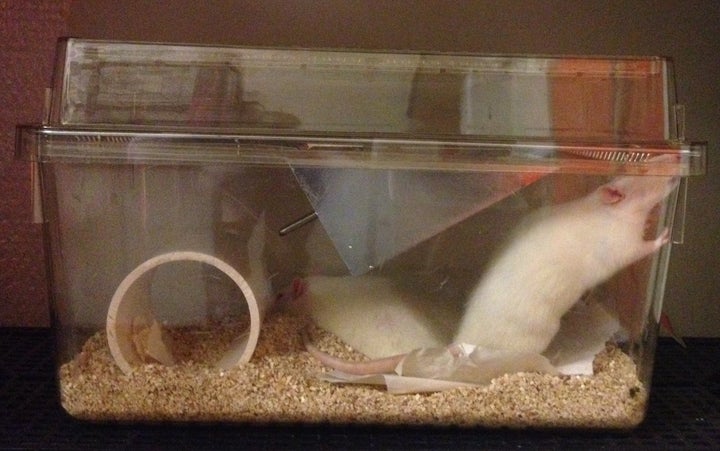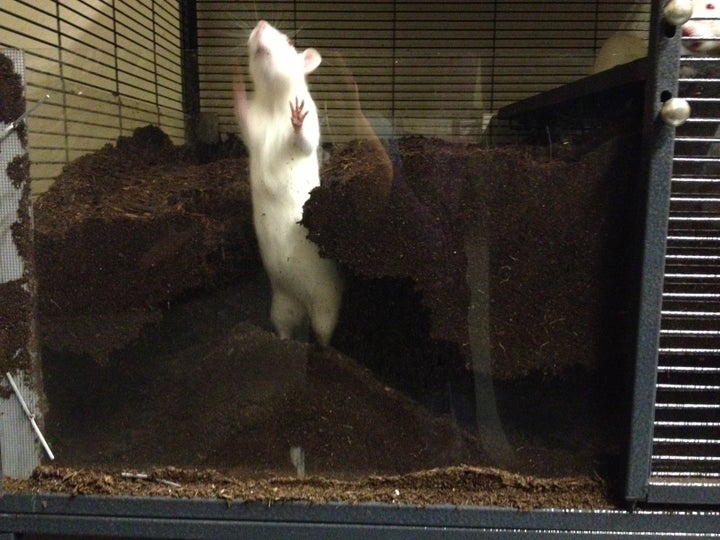
Research on rats and other animals has been credited with major advances in the treatment of all sorts of deadly ailments, including heart disease, cancer and Alzheimer's. In fact, it's been said that "practically every drug, treatment, medical device, diagnostic tool or cure we have today was developed with the help of lab animals."
But let's face it: Being a lab rat probably isn't much fun, and housing may be part of the problem. The typical lab rat spends its days in a cage so small that there's no room to climb or burrow or even to stand up straight.
And according to the leader of a study of lab rat behavior published June 29 in Royal Society Open Science, being cooped up like that compromises not only the animals' welfare but also the reliability of rodent research.
Scroll down to TAKE OUR POLL.
"These animals are not 'normal,' and therefore may yield 'abnormal' results," study leader Dr. Joanna Makowska of the University of British Columbia told The Huffington Post in an email. "This leads to lack of reproducibility between studies, as well as lack of validity of the results because these results may be idiosyncratic to the specific animals who were used in a particular study, rather than to 'rats' in general."
For the study, Makowska and Dr. Dan Weary, an animal welfare expert at the university, observed the behavior of rats housed in standard plastic enclosures, (45 × 24 × 20 cm) and in bigger wire enclosures (91 × 64 × 125 cm) that included soil for burrowing (see below).


The rats in the bigger, "semi-naturalistic" cages did a lot of climbing, burrowing and just standing upright. The rats in the standard cages didn't do those things. But the researchers noticed that those rats stretched out their bodies (a process scientists call pandiculation) nine times more frequently than their big cage counterparts.
As Makowska and Weary wrote in their paper, the extra stretching is likely "a corrective response to the stiffness and positional stress associated with restricted movements in standard cages."
Sounds unpleasant, for sure. But is there really any solid evidence that rats housed in standard cages are somehow unwell?
This remains an open question, said Dr. Larry Carbone, a lab animal veterinarian at the University of California at San Francisco and the author of the 2004 book What Animals Want: Expertise & Advocacy in Laboratory Animal Welfare.
"Any confinement limits their opportunities, but also, hopefully, limits things they don’t want, like food shortages, extreme weather, lurking predators," Carbone told HuffPost in an email. "So the challenge is figuring out which of those limitations actually affects the animals’ welfare."
In any case, cramped quarters may not be the only downside to life as a lab rat.
Recent research suggests that the animals can be stressed by the low temperatures maintained in some labs. And then there are all the things that lab rats experience in the course of experiments, which can include injections, surgical procedures and euthanasia.
In case you're wondering about legal protections for lab rats, it's complicated. Some federal regulations do address the treatment of lab animals. But while the all-important Animal Welfare Act protects the well-being of warm-blooded animals in general, it makes an exception for rats, along with birds and mice.
Those exceptions might be a matter of practicality, given the untold millions of rodents and the other unprotected animals housed in U.S. labs.
But Makowska sees another possible reason: People just don't like rats.
"Rats are less valued than other (larger, cuter) mammals," she said. "They have been blamed for the plague (which, incidentally, was recently shown to be untrue). They are viewed as pests. And they are constantly being vilified by the world of films, books and cartoons, where they are often made to be the symbol of malevolence."
Carbone said the study suggests ways in which regulations for housing animals in laboratories should be updated. "Scientists have to make sure that their use of animals really does lead to quality, useful data," he added, "and they have to do their best to meet current standards of animal welfare."
As for Makowska, she said rodents should be accorded the same ethical considerations as more charismatic animals. She called for more research -- and bigger cages.
